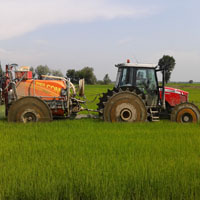Off-site movement of quinclorac from rice fields

Accepted: 24 March 2021
PDF: 431
All claims expressed in this article are solely those of the authors and do not necessarily represent those of their affiliated organizations, or those of the publisher, the editors and the reviewers. Any product that may be evaluated in this article or claim that may be made by its manufacturer is not guaranteed or endorsed by the publisher.
The off-site movement of quinclorac from rice paddies was studied in a district and field study during the 2014 and 2015 growing seasons. Quinclorac residues were monitored on in-field surface waters, and out-field water entering and leaving an irrigation district. The behaviour of quinclorac residues in paddy water pointed out that the movement of herbicides from interconnected paddies is not negligible. This phenomenon was particularly evident in the days following the re-flooding of paddies after spraying. The water entering the uphill paddy fields have partially flushed quinclorac residues in the downhill paddy fields. Both the district and the field studies, showed the continuous presence of quinclorac residues in inlet waters. Even because of the continuous uploading of residues from inlet waters, traces of quinclorac in paddy water were detected up to 70 DAT. The presence of quinclorac in inlet water could be related to phenomena of drainage and drift during herbicide application in the paddies located upstream. The analysis carried out on waters leaving the district showed the presence of quinclorac residues in all the outlet floodgates, particularly from the end of May and late August. The results of this study suggest that appropriate management practices adopted at field scale may be required to lower the water contamination at irrigation district level. Considering that the highest losses of quinclorac occurred during the first 10-15 days after its application, to prevent these losses could be helpful avoiding water discharge from the treated fields for at least this period of time. In addition, a deep effort must be laid upon education and training of farmers on these environmental thematic throughout specific initiatives organized by public and private stakeholders.
Highlights
- Quinclorac persistence in paddy water is affected by its residues in entering waters.
- Entering waters often contain quinclorac residues.
- A water holding period of at least 10 days may limit the offsite movement of quinclorac residues from paddy fields.
How to Cite

This work is licensed under a Creative Commons Attribution-NonCommercial 4.0 International License.
PAGEPress has chosen to apply the Creative Commons Attribution NonCommercial 4.0 International License (CC BY-NC 4.0) to all manuscripts to be published.

 https://doi.org/10.4081/ija.2021.1798
https://doi.org/10.4081/ija.2021.1798



